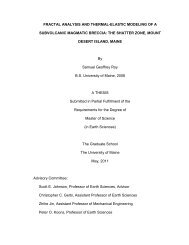Latis II Underwater Remotely Operated Vehicle Technical Report
Latis II Underwater Remotely Operated Vehicle Technical Report
Latis II Underwater Remotely Operated Vehicle Technical Report
Create successful ePaper yourself
Turn your PDF publications into a flip-book with our unique Google optimized e-Paper software.
ROV ELECTRONICS<br />
MAIN CONTROLLER<br />
At the heart of <strong>Latis</strong> <strong>II</strong> is a National Instruments<br />
Compact RIO controller (cRio). The cRio is most<br />
commonly used for data acquisition and<br />
automation control. The cRio on <strong>Latis</strong> <strong>II</strong> has<br />
slots for four drop-in modules, of which three<br />
are used. The team used two 9401 Digital<br />
Input/ Output modules, as well as a 9205<br />
Analog Input module. These modules are used<br />
to link the cRio processor to its environment<br />
through sensors and output devices.<br />
THRUSTERS<br />
Six BTD-150 Seabotix thrusters are used on <strong>Latis</strong><br />
<strong>II</strong> for propulsion. Three Sabertooth 2x10<br />
electronic speed controllers are used to<br />
regulate thruster power. Each Sabertooth<br />
controls two thrusters.<br />
SERVOS<br />
The motion of each arm joint is provided by a<br />
small hobby servo. Eight HS-7775MG Hitec<br />
servos are used for the shoulders, elbows, and<br />
grippers. Two HS-805BB Hitec servos are used<br />
for the shoulder rotation joint. All of the servos<br />
connect back to custom circuit boards in the<br />
main enclosure for control and power signals.<br />
SENSORS<br />
To provide feedback on internal and external<br />
conditions, <strong>Latis</strong> <strong>II</strong> is equipped with a variety of<br />
sensors.<br />
4<br />
� Phidgets Temperature and Humidity<br />
Sensor Board to measure thermal<br />
conditions inside the ROV enclosure<br />
� OMEGA Thermistor for measuring<br />
external water temperature<br />
� H1a Aquarian Audio Hydrophone for<br />
measuring external sound sources<br />
LATIS <strong>II</strong><br />
TECHNICAL REPORT<br />
CUSTOM CIRCUIT BOARDS<br />
To make it easier to interface to the cRio<br />
modules, three custom printed circuit boards<br />
(PCBs) were designed and manufactured. Each<br />
PCB connects to its cRio module through a<br />
ribbon cable, and connects to various devices<br />
through three-conductor cables commonly<br />
found in radio-control hobby electronics.<br />
THRUSTER BOARD<br />
The Thruster Board breaks six digital output<br />
channels from a 9401 module on the cRio into<br />
three-pin headers for the Sabertooth units to<br />
plug into. The remaining two channels are used<br />
to control the gripper servos. Each servo pulls<br />
power from the 5V supply through a PCBmounted<br />
3A fuse.<br />
Figure 1: Thruster PWM Board<br />
To work with this PCB, the 9401 module on the<br />
cRio is configured for pulse-width-modulation<br />
(PWM) output. Each channel produces a square<br />
wave with a duty cycle proportional to the<br />
desired speed.<br />
A resistor-capacitor (RC) circuit is used to filter<br />
the pulse with modulation (PWM) signal into an<br />
analog signal for the Sabertooth. The servos<br />
require an actual PWM signal, so no filtering<br />
circuit is used.

















